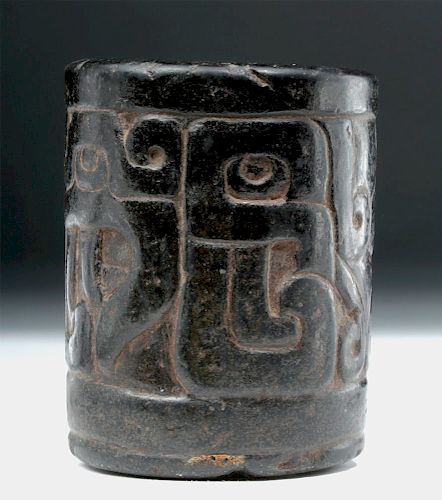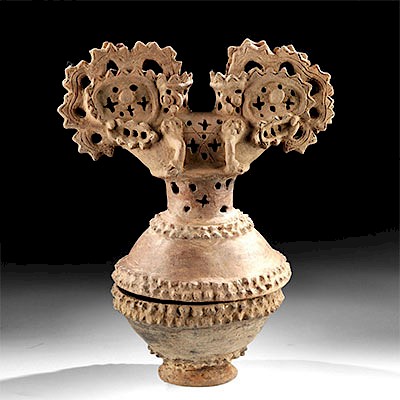Important Chavin Carved Stone Cup - Feline & Serpent
Lot 78c
About Seller
Artemis Fine Arts
686 S Taylor Ave, Ste 106
Louisville, CO 80027
United States
Selling antiquities, ancient and ethnographic art online since 1993, Artemis Gallery specializes in Classical Antiquities (Egyptian, Greek, Roman, Near Eastern), Asian, Pre-Columbian, African / Tribal / Oceanographic art. Our extensive inventory includes pottery, stone, metal, wood, glass and textil...Read more
Categories
Estimate:
$6,000 - $9,000
Absentee vs Live bid
Two ways to bid:
- Leave a max absentee bid and the platform will bid on your behalf up to your maximum bid during the live auction.
- Bid live during the auction and your bids will be submitted real-time to the auctioneer.
Bid Increments
| Price | Bid Increment |
|---|---|
| $0 | $25 |
| $300 | $50 |
| $1,000 | $100 |
| $2,000 | $250 |
| $5,000 | $500 |
| $10,000 | $1,000 |
| $20,000 | $2,500 |
| $50,000 | $5,000 |
| $100,000 | $10,000 |
| $200,000 | $20,000 |
About Auction
By Artemis Fine Arts
Aug 22, 2019
Set Reminder
2019-08-22 10:00:00
2019-08-22 10:00:00
America/New_York
Bidsquare
Bidsquare : Fine Ancient | Asian | Ethnographic Art
https://www.bidsquare.com/auctions/artemis-gallery/fine-ancient-asian-ethnographic-art-4348
Featuring classical antiquities, ancient and ethnographic art from cultures encompassing the globe, plus fine art. Egyptian, Greek, Roman, Etruscan, Near Eastern, Asian, Pre-Columbian, Native American, African / Tribal, Oceanic, Spanish Colonial, Russian, Fine Art, so much more! Artemis Fine Arts info@artemisfinearts.com
Featuring classical antiquities, ancient and ethnographic art from cultures encompassing the globe, plus fine art. Egyptian, Greek, Roman, Etruscan, Near Eastern, Asian, Pre-Columbian, Native American, African / Tribal, Oceanic, Spanish Colonial, Russian, Fine Art, so much more! Artemis Fine Arts info@artemisfinearts.com
- Lot Description
Pre-Columbian, Peru, Chavin, 900 to 200 BCE. A striking, thick-walled black stone cup with an incised relief image of highly abstract mythological beings around its body. Red cinnabar gives color to the lower profile areas of the relief carving, as well as the interior, which is conical in form, giving us a clue to the type of tool that made it - a drill, used to remove the sides but not able to form squared-off edges. The cup is flat on the base. This incised relief style is classically Chavin, the culture that is often compared to the Olmec of Mesoamerica for creating the first regional design style. When first made, the incised designs would have been entirely filled in with red. Size: 2.85" W x 3.5" H (7.2 cm x 8.9 cm)
The relief images are powerful and fierce, perhaps best understood if seen as a long, flattened image: two faces, each composed of distinctive bordered panels with reverse symmetry, one a feline, and one a serpent. The feline has three panels, two eyes above large fangs, and one in the center in the form of a large nose and mouth. The serpent is two panels, again eyes over fangs, with a v-shape to the lower jaw that gives it its serpentine look.
The feline and the serpent are the two most represented animals in the Chavin pantheon of mythological zoomorphic creatures. The Chavin lived in the northern Highland Andes, and their capital, Chavin de Huantar, is a UNESCO World Heritage Site. In the center of Chavin de Huantar is a massive, flat-topped pyramid, surrounded by lower platforms. Between 1200 and 500 BCE the pyramid space was used for religious ceremonies. The Old Temple, constructed very early in the history of the site, consists of a series of passageways built around a circular courtyard. Within were carved stone monuments showing jaguars, serpents, and other figures with transformative and/or anthropomorphic figures. At the very center was a towering stone stela depicting an anthropomorphic figure with a jaguar head, a human body, and eyebrows and hair made of snakes. This was Lanzon, the chief deity of Chavin. Researchers believe that worshippers ingested hallucinogenic drugs were led in the dark through the labyrinthine passageways before entering the central courtyard and coming abruptly face-to-face with the snarling features of the god.
Provenance: private Harrisburg, Pennsylvania, USA collection, from private 1950s South America collection
All items legal to buy/sell under U.S. Statute covering cultural patrimony Code 2600, CHAPTER 14, and are guaranteed to be as described or your money back.
A Certificate of Authenticity will accompany all winning bids.
We ship worldwide and handle all shipping in-house for your convenience.
#124091Light surface wear from age and handling, with some remaining red pigment. Old accession stickers are on the base.Condition
- Shipping Info
-
All shipping is handled in-house for your convenience. Your invoice from Artemis Gallery will include shipping calculation instructions. If in doubt, please inquire BEFORE bidding for estimated shipping costs for individual items.
-
- Buyer's Premium



 EUR
EUR CAD
CAD AUD
AUD GBP
GBP MXN
MXN HKD
HKD CNY
CNY MYR
MYR SEK
SEK SGD
SGD CHF
CHF THB
THB
















